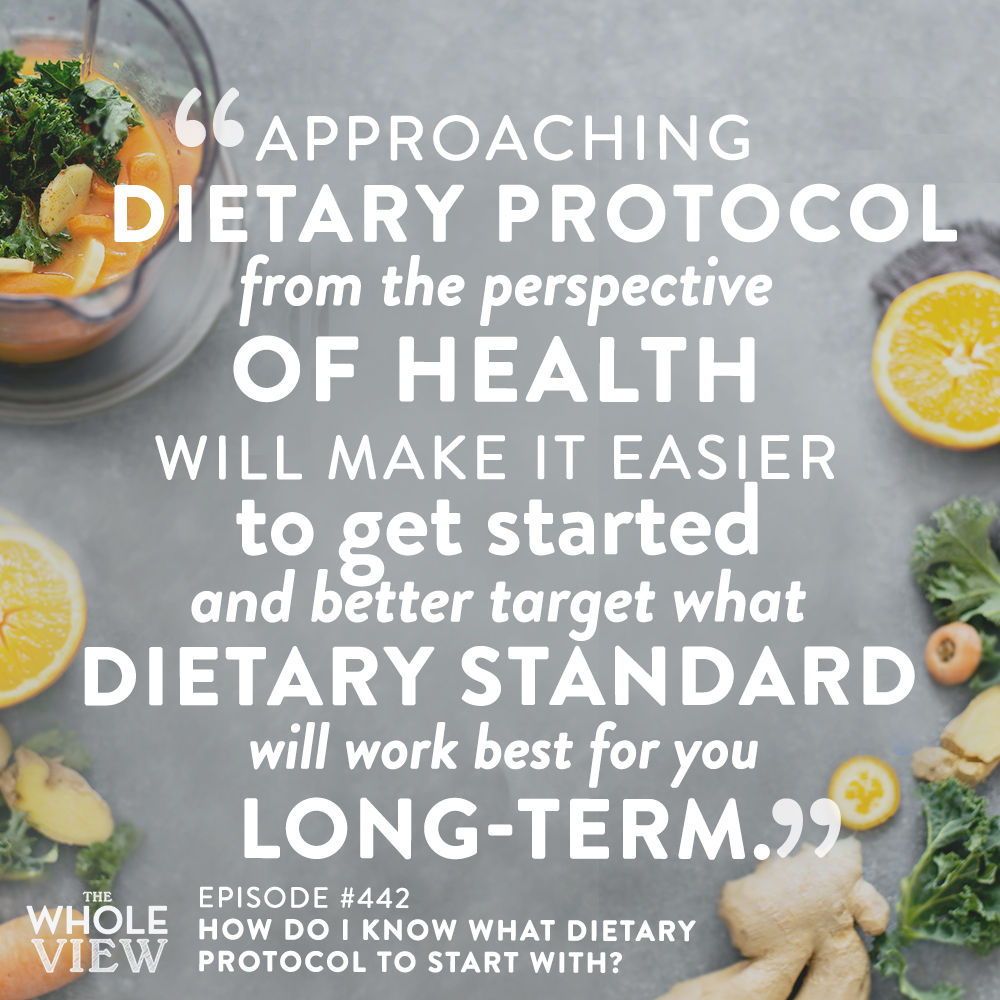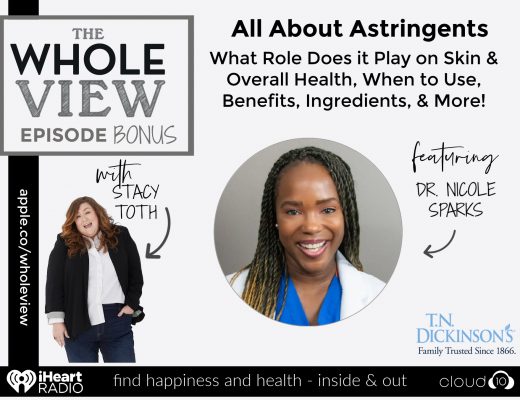
Welcome to episode 442 of The Whole View! This week, Stacy and Sarah look at the differences in dietary protocol. They share their personal experiences, and what the science shows is the best place to start!
If you enjoy the show, please review it on iTunes!
The Whole View, Episode 442: How Do I Know what Dietary Protocol to Start with?
Welcome back to episode 442 of the Whole View. (0:27)
Stacy welcomes listeners to the show! She hopes everyone has had a great start to the year so far, but if not, it’s a new month.
Today’s topic is dietary protocol. And Stacy hopes listeners have been seeing fewer advertisements and pressure to conform to a dietary standard that could end up making them not feel right.
She and Sarah, as always, will approach this topic from the perspective of addressing the difference in the dietary protocols that are focused on health.
Stacy also takes a moment to remind listeners that all the information in this show comes from a place of optimizing health.
They are not here to tell you to lose weight and fit into your jeans, but rather help you feel better, inside and out. This is a safe place to learn and not to feel pressured.
Listener Question
Sarah reflects on how much this show has documented her and Stacy’s individual health journeys and the ups and downs that they’ve experienced. (4:03)
They are not the type of people to hide their challenges to paint a rosy picture or endorse that approach.
Their main goal is to endorse a solution-oriented mindset about health, doable, approachable, and sustainable.
Sherly asks:
Hello Dr. Sarah and Stacy! I was so happy to find your podcast during these strange times and have found all your Covid shows so helpful. I understand that neither of you strictly follow any of the diets you talk about on the show (AIP, Sarah’s Gut Health Diet and Paleo) but rather used them to find out what worked best for you over time. For those of us just starting out how do we go about picking a diet to start from? Is there a hierarchy here? And where does being a “nutrivore” fit into all of this? Apologies if you have already covered this, but I am slowly working my way through your shows. I have come to trust your recommendations and I would like to re-do my own way of eating, I just don’t know where to start. Thanks in advance for your help!
The Quick Answer
Stacy explains that, in brief, the autoimmune protocol is an additional step beyond the paleo diet. Its driving strategy is to eliminate potentially inflammatory foods out of the diet still included in paleo (including nightshades).
Nutrivore is more concerned with nutrient-density and taking care of your gut microbiome health.
Sarah jokes and congratulates Stacy for pulling off a great elevator pitch! Though, Stacy urges listeners to stick around a bit longer because there is a lot more to the science behind these protocols.
Sarah explains that the lines between each dietary protocol are pretty blurry. She attributes that blurriness to how these lines are used to hone in on a personalized optimal diet.
She and Stacy have both used these protocols to target their individual triggers and build a diet that works for them.
Sarah and Stacy do not do on this show are rigid rules, “perfection-or-bust,” or one-side-fits-all.
Instead, they encourage the understanding of universal truths and bio-individuality.
The Dietary Protocol Hierarchy
Stacy reminds listeners that there is such a thing as taking too big of an initial jump. (13:16)
It’s essential to listen to your body and tell you what you need or crave.
Top Level: Nutrivore
The idea of nutrivore is to eat all the nutrients available, both essential and non-essential, that we need to thrive.
This includes nutrients to support a healthy gut microbiome and is very similar to the gut health diet.
The gut health diet provides just a little extra focus above and beyond nutrient sufficiency.
Sarah references Episode 437: Intro To Nutrivore as a great reference if you’re looking to focus on a nutrient-dense diet.
She thinks of this as a diet modifier, meaning you can apply nutrivore to any other diet template, including the other protocols on this list.
However, the exception to the “umbrella” of nutrivore is extreme diets, such as raw vegan, carnivore, or some keto variants, which cut out all food sources of specific nutrients.
Sarah explains the benefit of nutrivore is the ability to give the body all the “building blocks” it needs to do its job on a cellular level.
Paleo Plus or 80/20 Paleo
Sarah explains there are many different versions of the Paleo diet. (18:50)
This is a version that adds a few nutrient-dense, gut microbiome superfoods to provide some extra flexibility.
The most common additions are grass-fed (hopefully A2) dairy, traditionally-prepared legumes, sprouted pseudo-grains, and rice.
“Strict” Paleo
Ideally, this would be implemented with the guiding principles of a nutrivore approach. (20:01)
But it also eliminates empty calorie foods that are often allergy triggers or anything that wouldn’t have been available to our primitive ancestors.
The foods eliminated (processed/refined foods, grains, legumes, and dairy) most commonly drive inflammation while not contributing meaningfully in terms of nutrients.
Paleo should still include an elimination and challenge aspect.
This is where you do “strict” Paleo for a few weeks to months and then test your individual tolerance to non-Paleo foods to see how you react.
AIP
AIP is the strictest dietary protocol. (23:56)
Nutrivore is the core of this protocol but with the addition of eliminating a larger collection of foods known to cause inflammation.
On top of processed and refined foods, grains, legumes, and dairy, AIP also eliminates eggs, nightshades, nuts, seeds, alcohol.
This dietary protocol includes an equal focus on lifestyle, such as sleep, stress, activity, nature, and connection.
It involves three phases: Elimination, Reintroduction, Maintenance.
Sarah explains that AIP is not meant to be a long-term solution. But rather, the hope is to empower you through self-discovery and set you on a dietary path that works best for you as an individual
Lastly, Sarah recommends visiting the AIP Coach Directory if you’re interested in receiving more AIP information.
Dietary Protocol: Where To Start?
Stacy explains that everyone is different, and there is a lot of wiggle room to make sure they are working optimally for you. (27:30)
Moreover, many of them, especially FODMAP diets, aren’t meant to be upheld long-term. In those cases, they are more designed for symptom maintenance.
Sarah explains that anything layer to think about is food sensitivities.
There is an extra challenge when you have a hyperactive immune system and an unhealthy gut that you can develop allergies, intolerances, or sensitivities to foods that are always super healthy and otherwise something you wouldn’t eliminate.
Part of the self-discovery stage could include working with a specialist to target what could be triggering your individual symptoms.
Because we are all different, Sarah explains that deciding where to start depends on few different factors.
Health Challenges And Goals
This is the first side of the coins, Sarah explains. (33:47)
AIP is usually recommended for autoimmune disease or chronic disease.
Paleo or Paleo Plus is great for symptoms without a diagnosis, and using a food journal to target other potential food sensitivities.
Nutrivore or Paleo Plus works well for age-related health challenges.
And if you have no health challenges, in particular, Sarah recommends starting top-tier with Nutrivore.
Mitigating or managing autoimmune or chronic disease, AIP is a good strategy to use.
If you’re looking for a healthy weight loss (see our show on weight stigma!), Paleo or Paleo Plus might work best for you. Unless your weight gain is related to autoimmune diseases, like hypothyroidism.
Nutrivore or Paleo Plus is great for people looking for a performance diet or healthy aging.
And for general health, nutrivore is always a great protocol to implement.
Barriers
Sarah explains to listeners that you don’t want to make it so challenging day-to-day that you can’t stick with it. The idea is to set yourself up for success, see results, and improve your health.
We often justify actions centered on the idea of weight loss and claim that it’s for health.
Stacy reminds listeners that diet culture is so pervasive that we don’t even realize we’re swimming in it. And that we must look at whether or not we feel good.
Especially when it comes to inflammation and autoimmune. It’s very important for Stacy that her joint pain is manageable as she ages.
Stacy also shares that at one point, she was using dietary protocols and “getting healthy” as an excuse for losing weight.
She really wants to encourage everyone to ask those questions and challenge themselves and the reasons behind their choices.
You can want to be the best version of yourself while loving and respecting who you are today, without all the ugliness that comes with the culture around it.
Stacy also underlines the importance of emotional and lifestyle aspects and that you can’t just diet your way into being healthy.
A few solutions to overcoming barriers are education, coaching, support network, flexibility, and lifestyle before diet.
Maybe you’re just not used to shopping/cooking/eating this way.
It could be your budget, time management, energy, or symptoms getting in the way. Maybe your family isn’t on board (temptation, no support, cooking for 2+ different diets).
History of yo-yo diet, on-again-off-again, and bad relationships with food can also get in the way.
Final Thoughts
Sarah explains that sometimes the best place to start isn’t diet at all. (48:03)
Often, when she gets this question, she asks whether or not the person is getting enough sleep.
This way, we can set up for success before we even get started on changing our diet.
Sarah references this show for any listeners looking for a reference on the Science Of Habits.
She reminds listeners that this is a journey! There is no one way to do it, and any steps you take on that journey is a great way to do it.
This really comes down to who you are as a person and how you’re able to best perform a task- whether incrementally.
It needs to be an individual choice and a choice you’re willing to re-evaluate as you go.
Sarah underlines that the most important thing about starting a health journey is to start it.
Stacy adds that it’s not so much what step to take to get you started but what steps will be sustainable.
Stacy talks about how this played into the inspiration behind their third book, Real Life Paleo.
She reminds listeners that messing up isn’t a failure. It’s about continuing to try.
Sarah agrees, adding not to let perfection be the enemy of the good. It’s all about our choices, and we should never feel guilt or shame about them.
The key part of this journey is learning about our bodies well enough to know what we’ll be able to come back from and what we never want to repeat again (like the last time Sarah ate gluten).
Stacy encourages listeners to look at healthy choices as an act of self-love for themselves and their bodies.
Thank you so much for listening! Stacy and Sarah are so thankful to have such a fantastic community.





